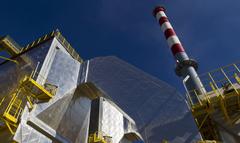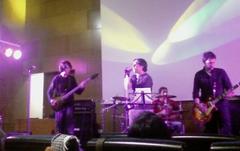Huelva Cathedral: Visiting Hours, Tickets, and Historical Sites Guide
Date: 04/07/2025
Introduction
Situated in the vibrant heart of Huelva, Spain, the Cathedral of Our Lady of Mercy (Catedral de Nuestra Señora de la Merced) is a monumental symbol of Andalusian religious, architectural, and cultural heritage. Initially constructed in the early 17th century as part of a Mercedarian convent, the cathedral has survived centuries of architectural transformation, natural disasters, and shifting societal roles. Its striking blend of Baroque and Neoclassical elements—most notably its pink-striped façade and luminous marble interior—makes it one of southern Spain’s most captivating sites (Wikipedia; Andalucia.com).
Huelva Cathedral, since its elevation to cathedral status in 1954, has been the spiritual center of the Diocese of Huelva. It houses significant religious artworks—including a revered replica of the Virgen de la Cinta, Baroque altarpieces, and paintings by renowned masters—reflecting both local devotion and the city’s artistic legacy (Diocesis de Huelva; Amused by Andalucia). Its central location in Huelva’s historic quarter allows for easy access to nearby landmarks, such as Plaza de la Merced and Casa Colón, making it an essential stop for visitors exploring Andalusia’s rich cultural tapestry (Spain.info; Barceló Guide).
This detailed guide provides essential information on visiting hours, ticketing, accessibility, travel tips, and the artistic and historical context of Huelva Cathedral—ensuring a rewarding and memorable experience.
Table of Contents
- Historical Overview
- Architectural Features and Artistic Heritage
- Visitor Information
- Nearby Attractions
- Frequently Asked Questions (FAQ)
- Conclusion and Call to Action
Historical Overview
Foundations and Early Development
Huelva Cathedral originated as the church of the Convento de la Merced, established by the Mercedarian Order in the early 1600s. Built in the Renaissance style with a basilica layout and three naves, the church served both the religious community and a growing Huelva population (Wikipedia; Andalucia.com).
Earthquakes and Reconstruction
The church endured several significant earthquakes, surviving the 1755 Lisbon quake but requiring extensive reconstruction after the 1765 event. Architect Pedro de Silva oversaw restoration from 1775, introducing Neoclassical elements alongside enduring Baroque features. In 1915, the addition of twin bell-gables gave the cathedral its recognizable silhouette (Andalucia.com; Spain.info; Wikipedia).
Cathedral Status and Modern Restoration
In 1953, the Diocese of Huelva separated from Seville, and the Church of La Merced was designated as its cathedral. Consecrated in 1954, it became the religious heart of the city (Diocesis de Huelva). The cathedral underwent major renovations after the 1969 earthquake, with preservation led by Rafael Manzano Martos. It was declared a National Monument in 1970 (Spain.info).
Artistic and Cultural Heritage
Among its artistic treasures are a replica of the Virgen de la Cinta, Baroque altarpieces, paintings by Francisco de Herrera el Viejo, and the family pantheon of the Counts of Niebla. The cathedral’s collection reflects the spiritual, artistic, and historical legacy of Huelva (Diocesis de Huelva; Andalucia.com).
Architectural Features and Artistic Heritage
Huelva Cathedral’s architecture is defined by its harmonious combination of Baroque exuberance and Neoclassical restraint. The façade—with alternating pink and white stripes—stands out among Andalusian cathedrals, while the interior’s white marble and abundant natural light create an atmosphere of reverence (Pineqone; Amused by Andalucia).
Inside, the main chapel’s gilded Baroque altarpiece and statue of Our Lady of Mercy serve as focal points. Side chapels house a range of religious artworks, including sculptures by Juan Martínez Montañés and paintings depicting biblical scenes. The choir stalls exemplify 17th- and 18th-century Spanish woodwork (Toma & Coe).
Other highlights include:
- The chapel of the Holy Sacrament, with intricate silverwork.
- Baroque and Neoclassical elements visible throughout the nave and chapels.
- Artistic contributions by local and regional sculptors and painters.
Visitor Information
Location and Accessibility
The cathedral is centrally located at Plaza de la Merced, within walking distance of other historic sites and easily accessible via public transport. The area is pedestrian-friendly, with nearby parking and bicycle rentals (Wildtrips).
Visiting Hours
- Monday to Saturday: 10:00 AM – 1:30 PM and 5:00 PM – 7:30 PM
- Sundays and Holidays: 11:00 AM – 1:30 PM
Note: Hours may vary during religious ceremonies or special events. Always check the official website or contact the cathedral before your visit.
Tickets and Guided Tours
- Admission: Free of charge.
- Guided Tours: Available through the cathedral office or local tour operators. Group and educational tours can be arranged in advance. Some special exhibitions may require a small fee.
Accessibility
- Wheelchair accessible via ramps at the main entrance.
- Accessible restrooms available.
- Staff can assist visitors with reduced mobility (contact in advance for arrangements).
Travel Tips
- Visit during weekday mornings for fewer crowds.
- Respect dress codes, especially during services.
- Photography is permitted (no flash) except during liturgical events.
- The area around Plaza de la Merced is lively with cafés and shops, ideal for post-visit exploration.
Nearby Attractions
- Plaza de la Merced: Palm-lined square with cafés and local shops.
- Casa Colón: Historic venue hosting exhibitions and events.
- Muelle de las Carabelas: Maritime museum with replicas of Columbus’s ships.
- Museo de Huelva: Archaeological and fine arts exhibits.
- Plaza de las Monjas: Popular square with further dining and shopping options.
Frequently Asked Questions (FAQ)
What are the Huelva Cathedral visiting hours?
Monday to Saturday, 10:00 AM–1:30 PM and 5:00 PM–7:30 PM; Sundays and holidays, 11:00 AM–1:30 PM. Always check for updates.
Is there an entrance fee?
Admission is free. Donations are welcome.
Are guided tours available?
Yes, through the cathedral office or local agencies. Advance booking is recommended.
Is Huelva Cathedral wheelchair accessible?
Yes, ramps and accessible restrooms are available.
Can I take photographs inside?
Photography is permitted without flash, except during services.
How do I get there?
The cathedral is in the city center, accessible by bus, taxi, or on foot.
Conclusion and Call to Action
Huelva Cathedral is a testament to Andalusia’s enduring faith, artistry, and community spirit. With its harmonious architecture, sacred artworks, and central cultural role, the cathedral offers a rewarding experience for history enthusiasts, art lovers, and travelers alike.
Plan your visit by checking the latest information on hours and tours. Enhance your trip with visits to nearby attractions, and download the Audiala app for guided audio tours and the most up-to-date visitor details. For further insights, explore our related articles and follow us on social media.
Start your journey into the heart of Huelva—let the cathedral be a highlight of your Andalusian adventure.
Images and Maps:
Include high-quality images of the cathedral’s exterior and interior with descriptive alt text, such as “Huelva Cathedral façade showcasing Baroque and Neoclassical architecture” and “Interior view of Huelva Cathedral main altar.” Embed an interactive map for easy navigation.



